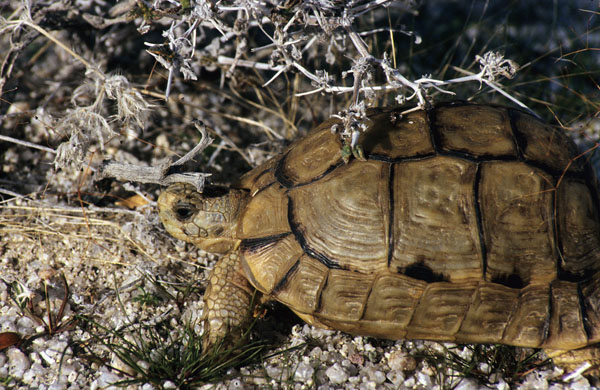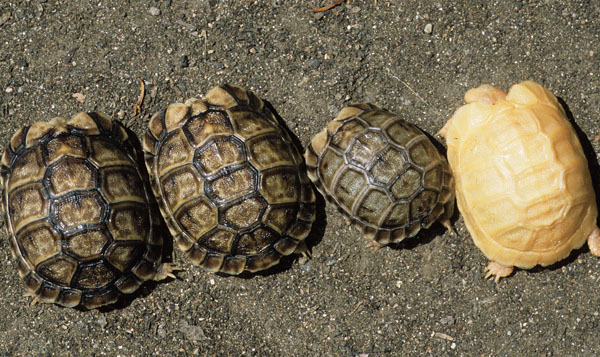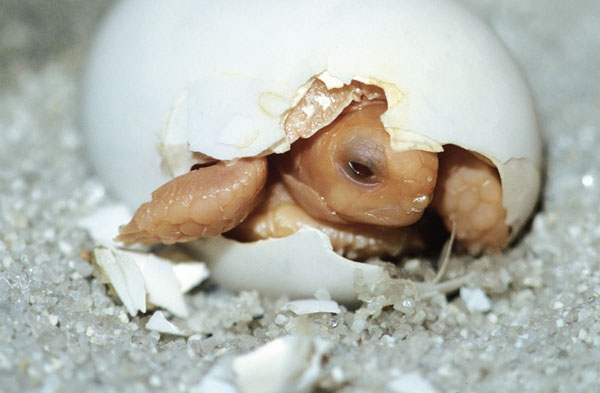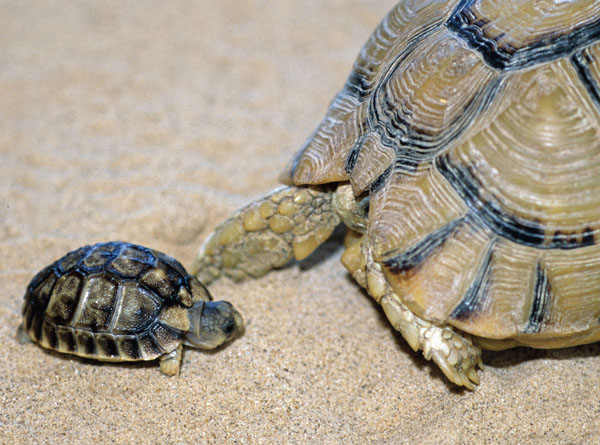The Egyptian tortoise is a challenging tortoise to keep, and it is not for the inexperienced keeper.
The Egyptian tortoise (Testudo kleinmanni), also called Kleinmann’s tortoise, was introduced to the pet trade 20 years ago. Historically found on the Southern boundary of the Mediterranean Sea on the north coast of Africa and the coastal Middle East, its range extends between Libya and Southern Israel and is reported to extend roughly 37 miles inland. However, recent studies place populations farther inland and farther east than previously thought.
The Egyptian tortoise is one of the smallest tortoises in the world, which seems to be the greatest appeal for tortoise keepers with limited space. The tortoise’s most distinctive features, besides its small size, are the two triangular markings on the bottom of its shell, which become more pronounced with age.
Read More
There is a sexual dimorphism between males and females, with adult size being the most pronounced feature. Males typically attain a size of approximately 4 inches in length and a weight of 105 grams on average. Females are much larger in size, attaining a length of approximately 5 inches and an average weight of 400 grams. The female’s shell is usually more domed than the male, but this is not always the case with captive-born-and-raised Egyptian tortoises. The adult male’s tail is noticeably longer, but this difference is not as evident in hatchlings and juveniles.

E.J. Pirog
The Egyptian tortoise is a protected species in Egypt and is also protected by CITES.
Egyptian Tortoise Desert Habitat
The Egyptian tortoise comes from a very harsh habitat consisting of sparsely vegetated, sandy soil. It can be very dry at times, with a range of 2 to 4 inches of rainfall per year and occasional coastal fog. The temperature averages 68 degrees Fahrenheit and varies between 54 to 86 degrees.
Finding Egyptian Tortoises
Today, the Egyptian tortoise is not only protected in Egypt, but it is protected by way of the Convention on International Trade in Endangered Species. It is listed as Appendix I, which offers the greatest protection within the agreement. The only way to legally obtain an Egyptian tortoise is through a breeder in your country of origin, because CITES permits are rarely issued for the transport of these tortoises across country boundaries, particularly in the case of the pet trade.

E.J. Pirog
Even though Egyptian tortoises are a little on the expensive side, they are available in most countries, including the United States.
The good news is that the tortoise is more frequently bred today than ever before, but the price has skyrocketed in the United States, with other countries getting similar prices. What is ironic about this trend is that the tortoise is being bred in much greater numbers around the world. The tortoise has become very popular in demand, but production has not kept up with that demand. Even though Egyptian tortoises are a little on the expensive side, they are available in most countries, including the U.S. They can be found through turtle and tortoise club members, organizations, advertising in reptile specialty magazines, reptile shows and directly from breeders.
A word of caution: Always view the tortoise before purchasing. If approached with a sale from out of the country, make sure all the shipping paperwork is in order and properly done, because if it is not, the first course of action is confiscation followed by possible legal action against you.
Care For Egyptian Tortoise Hatchlings
Anyone interested in keeping Egyptian tortoises should be aware that hatchlings are very tiny and quite delicate. They hatch out at about the size of a dime. It is best to purchase one from a dealer or breeder who has held onto the tortoise until it has had a chance to develop at least a few growth rings, just to be sure the tortoise is growing and relatively healthy.

E.J. Pirog
A hatchling’s diet is very important, and improper diet is usually the reason for baby Egyptian tortoise death.
Keep hatchling care as simple as possible. One can be kept in a sweater or plastic shoebox. Substrate such as paper towel, cloth towel or indoor/outdoor carpeting is usually best for hatchlings to yearlings. A baby-food jar lid makes an excellent water bowl. The tortoise should be soaked on a daily basis, even if water is available.
A hatchling’s diet is very important, and improper diet is usually the reason for baby Egyptian tortoise death. The diet should consist of dark, leafy greens, such as dandelion greens and plantain greens. Any of the dark, leafy lettuce you can get at a grocery store can be used. Although there is no hard-and-fast rule, you can feed them daily or every other day. With a balanced diet, overfeeding is not much of a concern. They will only eat as much as they are able. Fruits, such as apples, pears and bananas, can be used sparingly — a small portion once or twice a week. Keep in mind that a varied diet is the key to good development.
Take care with the types of greens you select. Greens that are high in oxalic acid, such as rhubarb, chives, parsley and spinach, are exceptionally hazardous to Egyptian tortoises. Oxalic acid binds with calcium to form calcium oxalate. This not only reduces the available calcium, but the way the Egyptian tortoise kidney works, it concentrates the solid, which will lead to kidney or bladder stones. This has lead to the death of many Egyptian tortoises.
There are quite a few pellet diets on the market that are nutritious and healthy, especially for Egyptian tortoises. I have found that the best are grain-based diets. By following the manufacturer’s instructions, with minor adjustments to account for individual metabolisms and the conditions under which they are kept, you’re almost guaranteed to raise a good-looking Egyptian tortoise. When using pellet diets, vitamin supplements are not necessary with the exception of the possible need for calcium carbonate. The diets contain D3 but not always enough calcium, and some individuals require more calcium than others.
Egyptian Tortoise Heat and Light for Little Ones
Heat and lighting become the next point of concern. The accepted temperature range for babies is 75 to 85 degrees. This needs to be done carefully, because the tortoise can be easily dehydrated or cooked if the proper lighting is not used. UVB lamps provide the essential ultraviolet light a tortoise needs to metabolize calcium for bone development along with other bodily functions. However, with the use of pellet diets, this is not always necessary, because all of the popular pellet diets contain vitamin D3. This makes selecting a lamp for a hatchling easier, because a lower-wattage lamp can be used. Another option is the use of UVB fluorescent tubes and an incandescent lamp for heat. An underside heat mat is yet another option as long as the heat is not trapped and a rheostat is used.

E.J. Pirog
A youngster and an adult.
When there is a discussion of heat with such a small creature, there is a very real possibility for dehydration. Yet, heat and hydration are the two most important aspects for proper development. To make sure the tortoise does not dehydrate, provide daily soakings as mentioned earlier. The other way to reduce dehydration is to provide a humid hide. This can be nothing more than a corner of the enclosure that is constantly kept moist. In order to retain moisture, this area can be covered with an inverted plastic container with an entrance cut into the side for the tortoise to access. It should be large enough for the tortoise to fit in and comfortably turn around in.
Egyptian Tortoise Care
Egyptian tortoises can reach adult size in four years, but they typically reach adult size in seven to 10 years. As they grow, their enclosure and environment should grow with them. The best indoor enclosure for adult Egyptian tortoises is a tortoise table, which is nothing more than a setup measuring 2 feet long, 2 feet wide and 2 feet tall. This would comfortably house a pair of adults. The size can always be larger, but this is a minimum.
Substrate can be anything from a sand/soil mixture to sand or soil by itself. Some keepers have had good success using crushed oyster shell or aspen bedding. The tortoises do not burrow, so 2 to 3 inches of substrate is enough. Deeper substrate, around 5 inches, should be provided for nesting adults. The rest of the adult care is identical to the hatchling care stated previously, except that the temperature range can go as high as 90 degrees on the warm end of the enclosure.
Using an outdoor enclosure is an option with adult Egyptian tortoises, but it is very difficult if the conditions are not just right. Most Egyptian tortoises appear to have a very narrow comfort range, and most successful keepers seem to do better maintaining their tortoises under controlled conditions indoors. There is also the concern of predators. An occasional outing in a screened covered area on a warm summer day is always a good suggestion for the tortoise; just make sure to provide a covered area to protect the tortoise from direct sunshine. This can measure 2 feet long, 2 feet wide and 2 feet tall.
The Egyptian tortoise is a challenging tortoise to keep, and it is not for the inexperienced keeper. However, that should not dissuade any tortoise keeper from obtaining this species, as long as they have completed the proper research and preparation. If given what it needs to thrive, the Egyptian tortoise can provide years of reward.
E. J. Pirog has maintained a collection of reptiles and amphibians with a focus on chelonians for more than 30 years. To the dismay of his wife, it’s more of an obsession than a passing interest, but his two daughters enjoy it. He also enjoys collecting herpetological literature and has an interest in photography and field study.


